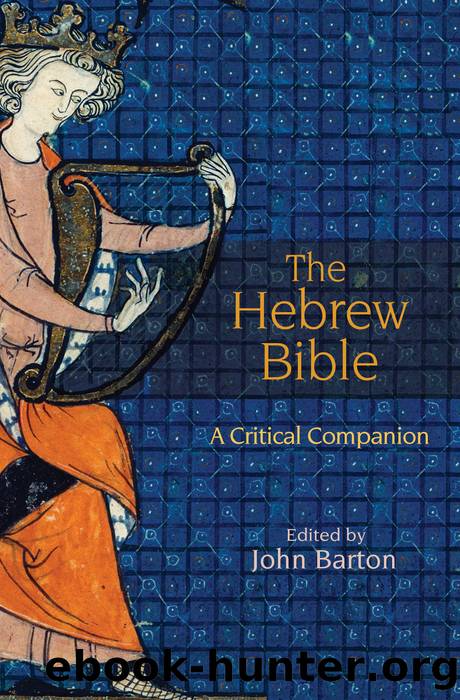The Hebrew Bible by John Barton

Author:John Barton [Barton, John]
Language: eng
Format: epub
ISBN: 9780691154718
Publisher: PrincetonUP
Published: 2016-07-15T05:00:00+00:00
HUMAN AND NONHUMAN CREATION
As well as the relationship between God and his people, the Old Testament pays significant attention to the connection between human beings and the physical world. This interest plays out at a number of different yet overlapping levelsâeconomic, sociopolitical, and theological.
In practical terms, the ancient Israelites, like their neighbors in the ancient Near East, were economically dependent on herding and farming, and therefore the Old Testament pays great interest to livestock and crops. The early chapters of Genesis record the transition from hunter-gatherers (Cain and Abel, Genesis 4) to nomadic herdsmen (e.g., Abraham and Lot, Genesis 12â13) to settled agriculturalists and pastoralists (e.g., Jacob, Gen. 37:1). In the arid conditions of the Near East, water is a precious commodity, so the provision of clean, safe water for people and animals is a practical necessity (Josh. 15:19) as well as a major theological theme (Exod. 17:1â7; Deut. 8:7). In addition, the text records numerous instances of conflict over water sources, whether natural springs or constructed wells (e.g., Gen. 26:19â22; 2 Kings 3:25).
The dependence of Israelite subsistence farmers on the earthâs productivity is highlighted by the attention given in the Old Testament to seasons and weather cycles, ranging from promises of regularity in the daily and annual rhythms (e.g., Gen. 8:22; Jer. 31:35â36) to reminders that Israelâs God is the guarantor of rains and harvests (e.g., Lev. 26:4; Deut. 11:14; Jer. 5:24). The book of Proverbs and other proverbial material include careful instructions on farming wisely and well (Prov. 27:23; Isa. 28:23â28) as well as warnings against poor practice (Prov. 20:4). Likewise, various instructions on sustainable farming practice as well as care for animals are found in the legal material in the Old Testament (e.g., Lev. 25:1â5; Deut. 20:19; 22:1â4, 6).
The relationship between people and the natural world is by no means always a positive one, for both pragmatic and theological reasons. In practical terms, the struggle to farm in often-inhospitable terrain with the ever-present threat of wild animals produces both an awareness of the dangers especially to livestock, as the young King David makes clear (1 Sam. 17:34â37), and a longing for an alternative idyllic reality where wild animals live at peace with humans and their livestock (Isa. 11:6â9, 35:1â2, 65:25). The wilderness (midbÄr) in the Old Testament is often portrayed by commentators either as a primitive idyll where Israel is totally dependent on her God or as a hostile and unforgiving desert.27 The reality is more nuanced than either of these extremes. The wilderness can be a harsh place associated with danger and privation (Exod. 14:11â12, 16:2â3), but it is also the place of Mosesâs encounter with God (Exod. 3) and of Godâs covenant with Israel (Exod. 19). Indeed, the portrayal of wilderness is often deliberately ambiguous, since God is present there despite the difficulties encountered (e.g., Gen. 21:14â19; Hosea 13:4â6).
The biblical authorsâ interest in nature can be seen in their care in observing and cataloging species (e.g., the detailed food laws in Leviticus 11, King Solomon in 1 Kings 4:33) and the frequent use of metaphors of nature to describe God (e.
Download
This site does not store any files on its server. We only index and link to content provided by other sites. Please contact the content providers to delete copyright contents if any and email us, we'll remove relevant links or contents immediately.
What Is the Gospel? (Foreword by D. A. Carson) by Greg Gilbert(970)
Daily Strength: Devotions for Bible Believing Study by Douglas Stauffer & Andrew Ray & Rick Quatro(878)
Jesus in Me by Anne Graham Lotz(848)
Christian Ethics by Wilkens Steve;(824)
The Practice Is the Path by Tias Little(797)
New Morning Mercies by Tripp Paul David(779)
Veritas: A Harvard Professor, a Con Man and the Gospel of Jesus's Wife by Ariel Sabar(710)
Cleaning Up Your Mental Mess by Dr. Caroline Leaf(707)
Greatest Mystery in the World by Og Mandino(629)
The Creative Call by Janice Elsheimer(565)
No More Christian Nice Guy by Paul Coughlin(556)
Our Appointment with Life by Thich Nhat Hanh(550)
2084 by John C. Lennox(536)
Monastic Archaeology by Unknown(526)
This One Wild and Precious Life by Sarah Wilson(517)
Jesus--Awesome Power, Awesome Love (Discover 4 Yourself® Inductive Bible Studies for Kids) by Kay Arthur(509)
The Duties of Parents by J.C. Ryle(487)
The Tale of the Tardy Oxcart (Swindoll Leadership Library) by Swindoll Charles R(469)
A Closer Talk with God: Scriptural Prayers for Women by Kim Trujillo(458)
